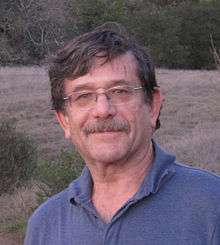Yoav Benjamini
Yoav Benjamini (Hebrew: יואב בנימיני; born January 5, 1949) is an Israeli statistician best known for development (with Yosef Hochberg) of the “false discovery rate” criterion. He is currently The Nathan and Lily Silver Professor of Applied Statistics at Tel Aviv University, Irsael.
Yoav Benjamini | |
|---|---|
 Yoav Benjamini | |
| Born | January 5, 1949 |
| Nationality | Israeli |
| Known for | False discovery rate BH procedure |
| Awards | Israel Prize (2012) NAS Member (2020) |
| Scientific career | |
| Fields | Statistics |
| Institutions | Tel Aviv University |
| Doctoral advisor | Peter Bloomfield |
Early life
Yoav studied mathematics and physics at the Hebrew University of Jerusalem, Israel and graduated in 1973. His masters degree in Mathematics from the same university in 1976. In 1981, he received his Ph.D. in Statistics from Princeton University, USA. [1]
Scientific fields of interest
Benjamini's scientific work combines theoretical research in statistical methodology with applied research that involves complex problems with massive data. The methodological work is on selective and simultaneous inference (multiple comparisons), as well as on general methods for data analysis, data mining, and data visualization. His research citations (from Google Scholar) exceeds 90,000. [2]
Honors and awards
- 2012 Israel Prize Recipient in statistics [3]
- 2020 Elected to the National Academy of Sciences (NAS), USA [4][5][6]
Publications
- 1983: "Is the T-test really conservative when the parent distribution is long-tailed", Journal of the American Statistical Association
- 1986: "Observational rainfall – runoff analysis for estimating effects of cloud seeding on water resources in Northern Israel", Journal of Hydrology (with Y. Harpaz)
- 1988: "Opening the box of a boxplot", The American Statistician
- 1990: "More powerful procedures for multiple significance testing", Statistics in Medicine (with Y. Hochberg)
- 1995: "Controlling the False Discovery Rate: a practical and powerful approach to multiple testing", Journal of the Royal Statistical Society, Series B (with Y. Hochberg)
- 1998: "Confidence intervals with more power to determine the sign: two ends constrain the means", Journal of the American Statistical Association (with Y. Hochberg & PB. Stark)
- 2000: "The adaptive control of the false discovery rate in multiple comparison problems", The Journal of Educational and Behavioral Statistics (with Y. Hochberg)
- 2001: The control of the False Discovery Rate in multiple testing under dependency, Annals of Statistics (with D. Yekutieli)
- 2002: John Tukey’s contributions to multiple comparisons, Annals of Statistics, (with H. Braun)
- 2003: Identifying Differentially Expressed Genes Using False Discovery Rate Controlling Procedures, Bioinformatics (with A. Reiner & D. Yekutieli)
- 2005: Genotype-environment interactions in mouse behavior: A way out of the problem, Proceedings of the National Academy of Sciences (with N. Kafkafi, A. Sakov & others)
- 2005: False discovery rate controlling confidence intervals for selected parameters, Journal of the American Statistical Association (with Y. Yekutieli
- 2006: Adapting to unknown sparsity by controlling the false discovery rate, Annals of Statistics (with: F. Abramovich, D. Donoho & IM. Johnstone)
- 2006: Adaptive linear step-up procedures that control the false discovery rate, Biometrika (with A.M. Krieger & D. Yekutieli)
- 2008: Screening for partial conjunction hypotheses. Biometrics (with R. Heller)
- 2011: Quantifying the buildup in extent and complexity of behavior – the case of free exploration in mice, Proceedings of the National Academy of Sciences (with E. Fonio, T. Galili and others)